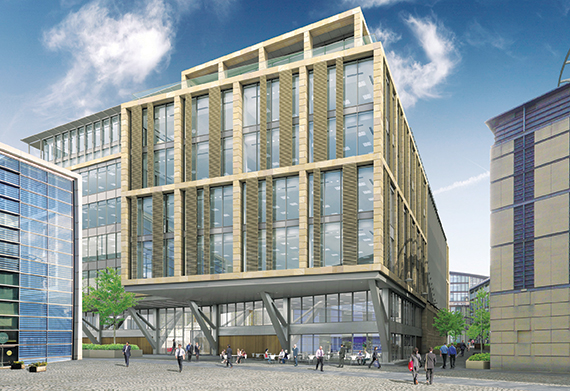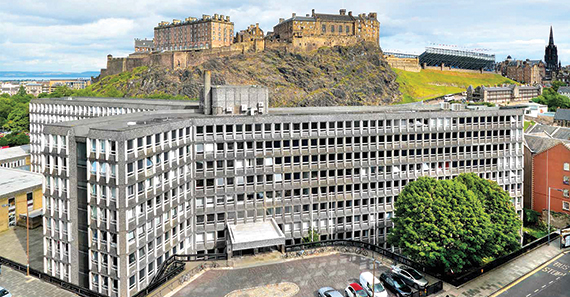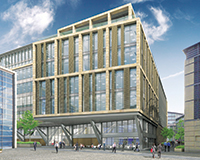One issue dominates the office market in both Edinburgh and Glasgow: supply of grade-A space. Or, more precisely, lack of it. In Edinburgh, where the shortage is most acute, recent healthy take-up (bolstered by Napier University taking 100,000 sq ft out of town) belies the fact that there is less than a year’s supply, with only one major scheme – M&G’s final building at Quartermile 3 (73,000 sq ft) – under construction, which won’t complete until Q4 2017.
Other schemes are in the pipeline: for example, GSS Development’s 2 Semple Street (35,000 sq ft) is due to start this month. One – Chris Stewart Group’s 60,000 sq ft The Mint Building on The Registers – is believed to be already under offer, reducing potential availability further.
“Occupiers’ choice will be limited for the next 12-24 months, with a number re-gearing their existing leases,” predicts Miller Mathieson, managing director of CBRE Scotland. Several corporates including KPMG and Deloitte are understood to be taking this route. Mathieson adds: “In the absence of alternatives, it’s difficult to see what else they’ll do, as even refurbished space is limited.”
This highlights the big difference between the Scottish capital and Glasgow, where refurbishment opportunities abound.
“Glasgow has a significant grade-B refurbishment pipeline of 620,000 sq ft, whereas Edinburgh will see only two schemes and 110,000 sq ft of grade-B space delivered in the short term,” confirms Cushman & Wakefield Edinburgh-based director James Thomson.
The paucity of space coming through in Edinburgh may well lead to further prelets, suggests Keith Dobson, head of Savills’ Edinburgh office: “We’re likely to see a ripple of deals as people try to secure what little space is available. As a result, we may well see a new prime rent of £34 per sq ft set this year.”
One type of occupier apparently undeterred by lack of city centre space is inward investors. Several requirements are currently circling Edinburgh, reports Bilfinger GVA associate director Peter Fraser. “Perhaps the recent city deal announcement (see feature p70) has played some part in this, but it certainly implies that the threat of Brexit has not curbed such demand,” he says.
Whether this type of company is more likely to take space at locations like Edinburgh Park remains to be seen. Although CBRE’s Mathieson expects rents there to soon reach £20 per sq ft, he suggests speculative development is unlikely. Nevertheless, last month Murray Estates put its Edinburgh International Business Gateway development site on the market, part of which is earmarked for a new office quarter.
Aberdeen
Aberdeen’s commercial markets are still coming to terms with the rollercoaster the last few years has taken them on. Reliance on a single sector (the oil and energy industry) has historically benefitted the city’s office market, but the last collapse in oil prices knocked it for six. At least a proactive city council has recognised the imbalance that has seen the bulk of office development take place outside the city centre, around the airport at Dyce. A masterplan to breathe life back into the city centre (see feature p72) is welcome, but won’t happen overnight.
Right now, local agents admit that the office market is depressed with a large chunk of space completing at just the wrong time. Three speculative developments are in the pipeline, providing nearly 300,000 sq ft of space (see panel). It’s a problem Edinburgh would dearly love to have, but the bulk of office demand in Aberdeen is for suites of less than 5,000 sq ft. Q1 take-up came in at just 35,000 sq ft – less than half of the 86,000 sq ft a year previously. At least this year’s Q2 got off to an optimistic start with PwC’s letting of the 10,000 sq ft top floor of the Capitol.
Although there is talk that PwC may have signed at a rent of £32 per sq ft, prime rents are generally deemed to be at the high £20 per sq ft mark, though there has been little evidence recently to show if values are starting to head back to the £32 levels achieved in the good times. Incentives have a much larger gap to close: whereas three months rent-free on a 15-year lease was a fair offer in the boom times, it is now closer to three years. Only two large requirements are currently in the market (Marathon and Total) and neither of those are definite movers. To compound matters, Aker Solutions, which agreed a jaw-dropping deal in 2014 to take 335,000 sq ft for its HQ at Dyce, is understood to be looking to sublet 100,000 sq ft.
Knight Frank partner Katherine Monro is pragmatic about the year ahead. She says: “There will be no more speculative development until the market changes. It has narrowed and we’re in a holding period. But we’ve been here before. There’s a sense that things are unlikely to improve this year and I think we’ll be well into 2017 before we see a marked improvement.”
Investment dominated by foreign buyers
A flurry of chunky investment deals in the first few months of 2016 has put the spotlight firmly on Edinburgh. These include the long-awaited sale of the city council’s 200,000 sq ft Atria building to German fund Deka for £105m, and the off-market purchase by another German investor, Triuva, of M&G’s 120,000 sq ft Quartermile 4 (pictured) for £68m.
 Germans aren’t the only ones queuing up for a slice of Edinburgh’s action, with Korean, Russian, and Spanish buyers all reported to be active as potential purchasers.
Germans aren’t the only ones queuing up for a slice of Edinburgh’s action, with Korean, Russian, and Spanish buyers all reported to be active as potential purchasers.
“We believe 2016 may well be a record year in terms of international buying activity in Edinburgh. We are aware of two or three deals that have been agreed off-market involving US and European funds,” says Bilfinger GVA senior director Stuart Agnew.
He adds that US opportunity funds and covenant buyers as well as Middle Eastern sovereign wealth funds and private investors are also likely to be active in the Scottish market this year. “These new international players are currently replacing the traditional UK institutions and we anticipate that this trend will continue throughout 2016.”
Although investment activity has slowed as a response to the Brexit referendum, the bigger issue facing Edinburgh is lack of stock, as many trophy buildings have recently changed hands and no new product will be completed for some time (see main text).
That may mean potential office buyers looking at other sectors (see research, p80). “We are seeing notable growth in specialist property investment,” notes Alasdair Steele, Knight Frank’s head of Scotland commercial, “particularly hotels and student accommodation, which have boomed in Edinburgh over the past five years.”
Energy Performance
On 1 September, new regulations on the energy performance standards of commercial buildings are due to come into force. Yet the Scottish government has struggled to communicate what it expects of building owners leading to much uncertainty in the market. Guidance that was expected in March finally appeared in late May. As a result, says Neil Wotherspoon, head of Tuffin Ferraby Taylor’s Edinburgh office: “The market is very much in denial. Clients aren’t ready and don’t understand the implications.”
The good news, at least for now, is that the new regulations are far from onerous and apply only to new lettings over 1,000 sq m. They require buildings to be brought up to 2002 standards and landlords have a choice of implementing an action plan of physical works over three and a half years, or changing behavioural use to achieve the same goals, which will be monitored by an annual reporting requirement.
As the penalty for non-compliance is a £1,000 fine, some property experts believe landlords may elect simply to stump up the cash, while others point out that many buildings already comply with the 2002 standards. There is a growing suspicion that the regulations are just the start of a clamp-down on building performance.
“The government is likely to up the ante and in a couple of years’ time could up the bar to 2008 or 2010 standards. That would much more serious for landlords,” says Wotherspoon. For the moment, however, investors are unlikely to be put off by the new rules.
Edinburgh tech sector shines
 Could Edinburgh become the new Shoreditch? An influx of bearded hipsters might be the proof of the pudding, though Mark Jones, Cushman & Wakefield’s Edinburgh-based director of occupier services is quick to point out that a large proportion of the city’s already sizeable tech sector doesn’t sit within the “studenty type of tech”.
Could Edinburgh become the new Shoreditch? An influx of bearded hipsters might be the proof of the pudding, though Mark Jones, Cushman & Wakefield’s Edinburgh-based director of occupier services is quick to point out that a large proportion of the city’s already sizeable tech sector doesn’t sit within the “studenty type of tech”.
Around 15,000 people are currently employed in the city in TMT jobs and Jones reckons there is room for plenty more: “The tech sector here is underprovided compared with London. There are potentially 6,000 tech-related jobs that could be created, which would be a big deal for Edinburgh.”
Successful companies like FanDuel and SkyScanner show the potential for businesses born and bred in the Scottish capital, something Jones attributes to a more entrepreneurial generation of students. “With one of the best universities of the world churning out tech graduates, there will always be a pool of labour here,” he says.
If recruitment isn’t much of an issue, finding offices to house new tech players may be, with availability of space in all size bands squeezed (see main text). Even incubator space may be hard to find, with around eight co-working locations across the city providing only around 40,000 sq ft. Edinburgh’s most successful tech incubator (and the UK’s largest), CodeBase, only two years old, has reportedly reached 100% occupancy of the 75,000 sq ft space it leases at Argyle House, in the shadow of Edinburgh Castle (above).











